Hands or Forks in Cuzco

In East Asia chopsticks are the utensils of choice, while in Euroamerica one must know which fork to use in a good restaurant or at a formal dinner. Nevertheless, in Cuzco, despite the influence of both China and Spain, for traditional foods eating with ones hands is preferred.
Even so, I know of no place where one never eats with ones hands. Etiquette and tradition just tell you that somethings are finger food and some require utensils. For example, where I am from no one eats crisp bacon or hamburgers with a fork. They require fingers to lift them to your mouth. Yet when I first came to the Andes, and burgers had only recently arrived, the middle and upper classes would carefully slice them into bites and delicately fork them upwards. They would even slice the fried chicken away from the bone into bite sized pieces before eating it with utensils, fork always in the left hand and turned arch up while the knife remained in the right hand.
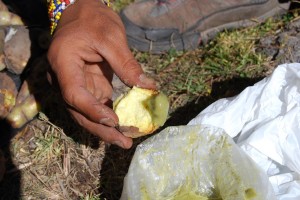
But when I joined a group of rural people, Aymara speakers in this case, for a lunch spread out on a cloth around which we all sat, we ate with our hands.
I never thought much about it until I came to Cuzco and a friend said that it was better to eat all food with the hands; it tasted better that way he claimed.
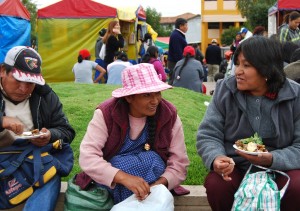
Indeed, in Cuzco the tradition that is dominant in rural areas continues in the city. Much food, especially the dishes they call “typical”, that is symbolic of Cuzco, are preferably eaten with the hands. Chiriucho, the ceremonial food par excellence, is an example. It is a dish of layers and includes baked guinea pig. One expects to eat it with the hands.

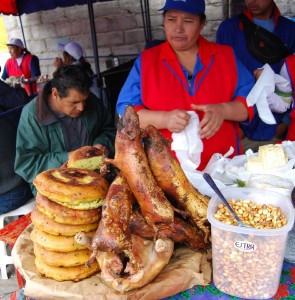
In rural areas people receive guests with a bowl of boiled potatoes, phuspo (boiled fava beans), mote (boiled kernels of once dried corn), and often a piece of meat. This is almost always eaten with the hands.
Recently in the city, when it was my birthday, I was served a big plate of juicy and well seasoned pork roast, called lechón. This pork did not come in thin slices with gravy, instead it was a big chunk with bone attached served on top of wayro potatoes. It smelled wonderful and was delicious. I was given neither a fork, a knife, or a spoon. The only utensil found was in the bowl containing the green uchukuta, the hot sauce, that passed from person to person. I lifted the hunk of meat to my mouth and tore bite sizes from it with my teeth, leaving my fingers greasy and holding tiny flakes of flavorful crust from the baked meat.
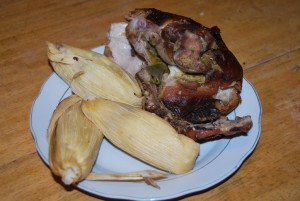
This was not how I was raised to eat meat, and it felt vaguely transgressive, even if fun. But any weird feelings I, as a North American, might have had were assuaged when I looked around the room and saw all the people who came to celebrate my birthday doing the same.
After the meal was over napkins and stretches of tissue were handed to each person for them to clean their hands.
In the finer restaurants of Cuzco that serve traditional food people generally use knives and forks, because that is what guests expect, but if you go into people’s homes you are likely to see them digging into a plate of most typical foods with their hands (although there are also dishes generally eaten with silverware). Soups will have spoons, but otherwise expect to use your fingers when it comes to typical foods.
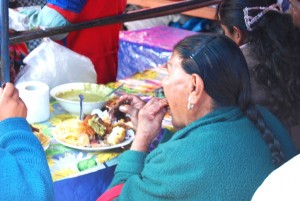
Recently the New York Times published an article about an upscale restaurant in that trend setting city that urges people to eschew silverware to enjoy their food with their hands. The resturanteurs argue that eating that way is more natural and brings people closer to their food in a more integral experience. They too claim the food tastes better when touched by your fingers.
Whether this trend will catch on I do not know, but many people in the Andes, including much of the population of Cuzco, carries on their indigenous custom of eating food with the hands. Of course there is an etiquette, but one learns that by watching and doing. In this way one comes closer to the Incas than walking all the stairs up to Machu Picchu.




